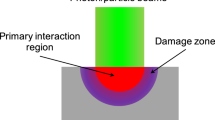Abstract.
The intense, ultra-fast electronic excitation of clean silicon (100)–(2×1) surfaces leads to the formation of silicon nanostructures embedded in silicon, which photoluminesce in the yellow-green (∼2-eV band gap). The silicon surfaces were irradiated with slow, highly charged ions (e.g. Xe44+ and Au53+) to produce the ultra-fast electronic excitation. The observation of excitonic features in the luminescence from these nanostructures has recently been reported. In this paper we report the dispersion of the excitonic features with laser excitation energy. A phonon-scattering process is proposed to explain the observed dispersion.
Similar content being viewed by others
Author information
Authors and Affiliations
Additional information
Received: 2 October 2001 / Accepted: 18 July 2002 / Published online: 25 October 2002
RID="*"
ID="*"Corresponding author. Fax: +1-925/423-7040, E-mail: Hamza1@llnl.gov
RID="**"
ID="**"Present address: University of California, Lawrence Berkeley National Laboratory, Berkeley, CA 94 720, USA
Rights and permissions
About this article
Cite this article
Hamza, A., Newman, M., Thielen, P. et al. Exciton dispersion in silicon nanostructures formed by intense, ultra-fast electronic excitation . Appl Phys A 76, 313–317 (2003). https://doi.org/10.1007/s00339-002-1814-9
Issue Date:
DOI: https://doi.org/10.1007/s00339-002-1814-9




